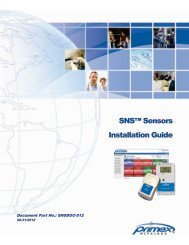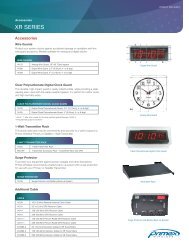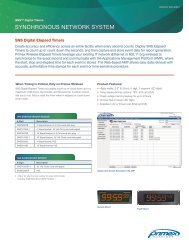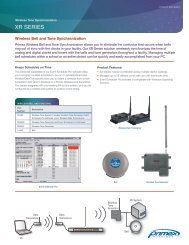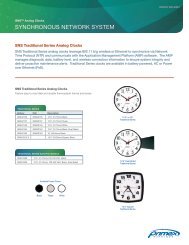GPS AND RADIO-CONTROLLED TIME - Primex Wireless
GPS AND RADIO-CONTROLLED TIME - Primex Wireless
GPS AND RADIO-CONTROLLED TIME - Primex Wireless
Create successful ePaper yourself
Turn your PDF publications into a flip-book with our unique Google optimized e-Paper software.
<strong>GPS</strong> <strong>AND</strong> <strong>RADIO</strong>-<strong>CONTROLLED</strong> <strong>TIME</strong><br />
<strong>Primex</strong> <strong>Wireless</strong>, Inc.<br />
OVERVIEW<br />
Since the days of the Industrial Revolution, American businesses have recognized the importance of accurate time.<br />
Several new technologies emerged in the 20th century to help improve time-measurement techniques. Each is based on<br />
atomic time generation: both radio waves and global-positioning-system (<strong>GPS</strong>) satellites distribute precise atomic time<br />
to clocks and other timekeeping devices. This paper explores the similarities and differences between radio-controlled<br />
and <strong>GPS</strong>-based clocks.<br />
GENERAL INTRODUCTION<br />
Before about 1949, astronomical sightings determined absolute time. But because these sightings were not very accurate,<br />
scientists began to look for a universally repeatable method for standardizing time. The time standard for the United<br />
States is known as "Mean Solar Time." Our clocks use Mean Solar Time, which is a uniform measure averaged out over<br />
a year (365.243... days). The local Mean Solar Time on the Greenwich meridian is called "Greenwich Mean Time"<br />
(GMT).<br />
People sometimes use the term "Greenwich Mean Time" to refer to Corrected Universal Time (UT1). UT1 is not actually<br />
a measure of time but rather a reference to the orientation angle of the earth. When we talk about time using space as its<br />
reference, it is important to realize that time is not predictable because of the slight wobble in the earth’s axis, which is<br />
called "rotational precession." This imperfect rotation has led scientists and mathematicians to find a way to correlate<br />
these angles to time. Different places view time through different meridians. For example, Eastern Standard Time (EST)<br />
is the Mean Solar Time of the meridian at 75 degrees W.<br />
The actual standard of time that scientists track and control is often called "Coordinated Universal Time" (UTC). UTC is<br />
a compromise between the highly stable atomic time and the irregular Earth rotation. A connection with UT1 is necessary<br />
to keep Earth rotational values accurate. That’s why scientists depend on leap seconds—by adding or subtracting<br />
them from time to time, they maintain a link with UT1. It is important to note that UTC is not a physical realization but<br />
only a prediction based on time in a laboratory, and that differences between labs can vary by as much as 10 nanoseconds.<br />
There are many labs throughout the world that predict time for correlation purposes.<br />
ATOMIC CLOCKS<br />
Today, atomic clocks represent the standard for highly accurate timekeeping devices, and the term "atomic time" is commonly<br />
used to connote the most precise time available. But "time," in the case of atomic clocks, is actually developed<br />
from an atomic frequency standard. A "frequency standard" generally refers to anything that generates a periodic signal,<br />
and a "clock" is a device that displays a time interval relative to a period of oscillation. The time on an atomic clock at<br />
the U.S. Naval Observatory in Washington, D.C., determines the time we set on our clocks. The National Institute of<br />
Standards and Technology (NIST) also maintains atomic clocks that are calibrated to the U.S. Naval Observatory’s<br />
clock.<br />
Just as the Celsius temperature scale is calibrated to the freezing and boiling points of water at sea level, time is synchronized<br />
to the natural orbiting rhythms of electrons in such elements as cesium 133, hydrogen, or rubidium. When a specific<br />
frequency of microwaves bombards these electrons, their orbits resonate and release energy. The microwave frequency<br />
at which this occurs is divisible down to an exact second and becomes the time base for an atomic clock.<br />
Cesium, which resonates at a frequency of 9,192,631,770 Hz, is the most common type of atomic clock.<br />
Atomic clocks are extremely accurate. Some atomic clocks now claim to have an accuracy of plus or minus one second<br />
in 20 million years! An atomic clock must be calibrated to the standard at the U.S. Naval Observatory (or a NIST standard).<br />
<strong>RADIO</strong>-<strong>CONTROLLED</strong> CLOCKS<br />
Some clocks on the market that are labeled "atomic" really are not. Rather, they are synchronized by a radio signal to an
atomic clock located at a NIST facility in Fort Collins, Colorado, and thus are more accurately described as "radio-controlled"<br />
clocks.<br />
At the NIST facility in Colorado, the government operates a 23-kW transmitter at a low frequency of 60 kHz. This transmitter,<br />
licensed as station WWVB, continually broadcasts the time and date as a series of slow data pulses. At 60 kHz,<br />
the WWVB signal consists of mostly magnetic waves that, like an insect flittering on the surface of a pond, generate ripples<br />
in the earth’s magnetic field. Through an array of long antennas at the NIST site, this time signal is broadcast<br />
throughout most of the North American continent. Transmitters similar to this are located in different areas of the world,<br />
such as London, England, where the British Broadcasting Company transmits at a different frequency of 198 kHz.<br />
Although these low frequency waves do an adequate job of conforming to the terrain of the earth, the waves have a difficult<br />
time penetrating some metal structures, and they are sharply polarized.<br />
Being "polarized" means that invisible flux lines striate the magnetic field, similar to the grain in a piece of wood. These<br />
flux lines, which run perpendicular to the direction that the waves are traveling, can twist due to aberrations in the environment.<br />
One detriment of a polarized signal is that it requires the receiving antenna (located inside clocks or watches)<br />
to be oriented properly for best signal detection. This isn’t a big problem for watches since the wearer moves about during<br />
the day, allowing the watch to be properly oriented often enough to receive the signal and update the time.<br />
Physical orientation becomes more of an issue with fixed wall clocks. Once they’re mounted, these clocks don’t move,<br />
so it is imperative that they be mounted in a position that allows the internal antenna to receive the WWVB signal. The<br />
need to properly orient the clock imposes limitations on where the user can mount it, and these clocks must also be kept<br />
away from sources of low-frequency electrical or magnetic interference such as motors or computer screens.<br />
<strong>GPS</strong>-BASED CLOCKS<br />
The Global Positioning System consists of a network of 24 orbiting satellites, each with its own cesium or rubidium<br />
atomic clock on board. The purpose of this network of satellites is to facilitate an electronic means of determining the<br />
longitude and latitude coordinates of any place on Earth. This is possible through a technique called 3-D trilateration,<br />
which measures the distance to several satellites.<br />
A certain distance from a satellite, in all directions, defines a sphere. If you can measure the distance to three satellites,<br />
you have defined three intersecting spheres. The intersection of two spheres is a circle and the intersection of three<br />
spheres is two points. A fourth intersecting sphere is required to define a single point. Ignoring altitude, the globe of the<br />
earth can be this fourth sphere. If four satellite signals are received, it’s possible to calculate elevation as well.<br />
We measure distance to a satellite by the time it takes a microwave signal to travel from a satellite to a specific point on<br />
Earth. Here is a brief analogy of how one can calculate distance by knowing the delay time. Let’s say you work at a factory<br />
where they always blow the noon whistle just as the second hand on your watch passes 12. One day you are home<br />
from work and you hear the factory whistle in the distance just as the second hand on your watch is 10 seconds past<br />
noon. You can calculate the distance to the factory based on the knowledge that sound travels at 770 miles per hour<br />
(mph) and the sound arrived at your home 10 seconds late by your watch. A speed of 770 mph equals 0.214 miles per<br />
second, so calculations indicate the factory is 2.14 miles away.<br />
A <strong>GPS</strong> receiver works in a way similar to the above scenario, except that it calculates the distance to orbiting satellites<br />
by measuring the delay in the arrival of microwave signals it receives from the satellites. Microwave signals travel at<br />
nearly the speed of light. Atomic clocks on all the orbiting <strong>GPS</strong> satellites initiate a precisely simultaneous series of data<br />
transmissions. On Earth, the signals from three or four of these satellites arrive at a <strong>GPS</strong> receiver at slightly different<br />
times, depending on the distance the signal traveled from each satellite.<br />
In the factory example above, if you didn’t know exactly what time the whistle actually blew, you couldn’t measure the<br />
delay to make the distance calculation. Likewise, a <strong>GPS</strong> receiver needs to know the exact time the signals left the satellites<br />
in order to measure the time delay of each satellite’s signal. The <strong>GPS</strong> receiver must derive the exact time in order to<br />
calibrate its internal quartz clock to true atomic time. The information required to do this comes from the delayed signals<br />
being received from at least three satellites.
The synchronizing signals from <strong>GPS</strong> satellites experience time delays due to the long distances they travel as they come<br />
to Earth. However, the <strong>GPS</strong> receivers carry what is called a firmware "almanac," which enables them to determine the<br />
location of each satellite at any time, and thus calculate the actual distance to each satellite. This enables the <strong>GPS</strong> receiver<br />
to compensate for the known signal delay. It uses this correction data to reconstruct the actual time that is in the atomic<br />
clocks aboard the satellites. In other words, the <strong>GPS</strong> time signal is adjusted to correct for propagation delay.<br />
The <strong>GPS</strong> receiver adjusts its own clock until the signal arrival times make sense compared to position data reported by<br />
each satellite. Once the <strong>GPS</strong> receiver acquires signals from at least three satellites, its internal clock is set to near-perfect<br />
agreement with the atomic clocks aboard the satellites. The satellite clocks are calibrated to the time standard at the<br />
NIST and the U.S. Naval Observatory.<br />
It may take some time for three or more satellites to orbit into view of the <strong>GPS</strong> receiver. This is why it sometimes takes<br />
several minutes to extract the time from a <strong>GPS</strong> receiver. After the <strong>GPS</strong> receiver’s clock is set, it can then determine the<br />
time delays and calculate the distance to each satellite.<br />
<strong>RADIO</strong>-<strong>CONTROLLED</strong> VS <strong>GPS</strong> <strong>TIME</strong><br />
As discussed earlier, the physical orientation of radio-controlled wall clocks and proximity to metal structures or sources<br />
of interference can affect reliability. Also, the distance of the receivers from the WWVB source can be thousands of<br />
miles away. This distance causes slight delays in the time registered on radio controlled clocks. The WWVB signal also<br />
weakens with distance from Fort Collins making signal reception more unreliable. Reception is also affected by weather<br />
and ground moisture conditions.<br />
The <strong>Primex</strong> <strong>GPS</strong> <strong>Wireless</strong> Clock System overcomes most of the disadvantages of radio-controlled clocks. The system<br />
corrects signal propagation delays to yield exact time anywhere on Earth. The <strong>GPS</strong> receiver is not sensitive to orientation,<br />
other than that it needs a view of the sky. With the <strong>Primex</strong> <strong>Wireless</strong> system, the <strong>GPS</strong> signal is locally rebroadcast in<br />
a building at a 72.1- to 72.4 MHz frequency that is less prone to noise signals than the WWVB broadcast frequency of<br />
60 kHz and more easily penetrates walls and metal structures. The <strong>GPS</strong> signal is also less affected by weather conditions,<br />
and the receiver can pick it up anywhere in the world.<br />
Since the WWVB signal is amplitude-modulated (AM), it is susceptible to electrical noise, both man-made and weatherrelated.<br />
This interference can mask synchronizations of WWVB clocks. <strong>Primex</strong> <strong>Wireless</strong> clocks are synchronized by an<br />
FM signal, which is less prone to interference. Furthermore, <strong>GPS</strong> clocks can receive synchronization six times a day,<br />
whereas most WWVB clocks only look for a signal four times a day. <strong>GPS</strong> clocks will be inherently more accurate just<br />
because they synchronize more often and won’t drift as far.<br />
Finally, during midday hours WWVB sky waves cannot be detected beyond 500 miles of Fort Collins, Colorado.<br />
Outside this radius WWVB clocks may only see three synchronizations per day compared to a <strong>GPS</strong> clock’s six synchronizations.<br />
CONCLUSION<br />
While both methods provide accurate ways to derive time, radio-controlled clocks have more limitations due to their<br />
inherent design. These clocks may be acceptable for typical residential and consumer applications, but they are not a<br />
good fit in commercial buildings. The materials used in the construction of schools, hospitals, and office buildings often<br />
interfere with the radio transmission required to synchronize radio-controlled clocks.<br />
<strong>GPS</strong>-based systems, on the other hand, function well in commercial building applications. The locally broadcast time<br />
signal penetrates every type of construction material. The signal is not affected by weather conditions. Users can locate<br />
clocks virtually anywhere in a building. As long as they are in range of the local transmitter, they’ll always be synchronized<br />
and perfectly accurate.



